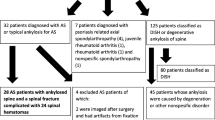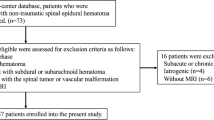Abstract
Objectives
The purpose of this study was to evaluate the diagnostic value of a spreading epidural hematoma (SEH) and deep subcutaneous edema (DSE) as indirect signs of posterior ligamentous complex (PLC) injuries on MR imaging of thoracolumbar burst fractures.
Materials and Methods
We retrospectively reviewed spinal MR images of 43 patients with thoracolumbar burst fractures: 17 patients with PLC injuries (study group) and 26 without PLC injuries (control group). An SEH was defined as a hemorrhagic infiltration into the anterior or posterior epidural space that spread along more than three vertebrae including the level of the fracture. A DSE was regarded as a fluid-like signal lesion in the deep subcutaneous layer of the back, and its epicenter was at the burst fracture level. The frequency of the SEH/DSE in the two groups was analyzed. In addition, the association between each sign and the degree of vertebral collapse, the severity of central canal compromise, and surgical decisions were analyzed.
Results
Magnetic resonance images showed an SEH in 20 out of 43 patients (46%) and a DSE in 17 (40%). The SEH and DSE were more commonly seen in the study group with PLC injuries (SEH, 15 out of 17 patients, 80%; DSE, 16 out of 17 patients, 94%) than in the control group without PLC injuries (SEH, 5 out of 26, 19%; DSE, 1 out of 26, 4%) (P <0.0001). The SEH and DSE were significantly associated with surgical management decisions (17 out of 20 patients with SEH, 85%, vs 8 out of the 23 without SEH, 35%, P =0.002; 15 out of 17 with DSE, 88%, vs 10 out of 26 without DSE, 38%, P =0.002). The SEH and DSE did not correlate with the degree of vertebral collapse or the severity of central canal compromise.
Conclusion
The SEH and DSE may be useful secondary MR signs of posterior ligamentous complex injury in thoracolumbar burst fractures.



Similar content being viewed by others
References
Holdsworth FW. Fractures, dislocations, and fracture-dislocations of the spine. J Bone Joint Surg Br. 1963;45:6–20.
Denis F. The three column spine and its significance in the classification of acute thoracolumbar spinal injuries. Spine. 1983;8:817–31.
James KS, Wenger KH, Schlegel JD, et al. Biomechanical evaluation of the stability of thoracolumbar burst fractures. Spine. 1994;19:1731–40.
Holdsworth FW. Fractures, dislocations and fracture dislocations of the spine (review). J Bone Joint Surg Am. 1970;52:1534–51.
Ferguson RL, Allen BL Jr. A mechanistic classification of thoracolumbar spine fractures. Clin Orthop. 1984;189:77–88.
Jelsma RK, Kirsch PT, Rice JF, et al. The radiographic description of thoracolumbar fractures. Surg Neurol. 1982;18:230–6.
Vaccaro AR, Lehman RA, Hurlbert RJ, et al. A new classification of thoracolumbar injuries. The importance of injury morphology, the integrity of the posterior ligamentous complex, and neurologic status. Spine. 2005;30:2325–33.
Vaccaro AR, Baron EM, Sanfilippo J, et al. Reliability of a novel classification system for thoracolumbar injuries: the thoracolumbar injury severity score. Spine. 2006;31:S62–9.
Haba H, Taneichi H, Kotani Y, et al. Diagnostic accuracy of magnetic resonance imaging for detecting posterior ligamentous complex injury associated with thoracic and lumbar fractures. J Neurosurg. 2003;99:20–6.
Lee HM, Kim HS, Kim DJ, et al. Reliability of magnetic resonance imaging in detecting posterior ligament complex injury in thoracolumbar spinal fractures. Spine. 2000;25:2079–84.
Goradia D, Linnau KF, Cohen WA, et al. Correlation of MR imaging findings with intraoperative findings after cervical spine trauma. Am J Neuroradiol. 2007;28:209–15.
Groves CJ, Cassar-Pullicino VN, Tins BJ, et al. Chance-type flexion-distraction injuries in the thoracolumbar spine: MR imaging characteristics. Radiology. 2005;236:601–8.
Bernstein MP, Mirvis SE, Shanmuganathan K. Chance-type fractures of the thoracolumbar spine: imaging analysis in 53 patients. Am J Roentgenol. 2006;187:859–68.
Terk MR, Hume-Neal M, Fraipont M, et al. Injury of the posterior ligament complex in patients with acute spinal trauma: evaluation by MR imaging. Am J Roentgenol. 1997;168:1481–6.
Author information
Authors and Affiliations
Corresponding author
Rights and permissions
About this article
Cite this article
Kim, N.R., Hong, S.H., Choi, JY. et al. Spreading epidural hematoma and deep subcutaneous edema: indirect MRI signs of posterior ligamentous complex injury in thoracolumbar burst fractures. Skeletal Radiol 39, 767–772 (2010). https://doi.org/10.1007/s00256-009-0868-6
Received:
Revised:
Accepted:
Published:
Issue Date:
DOI: https://doi.org/10.1007/s00256-009-0868-6




